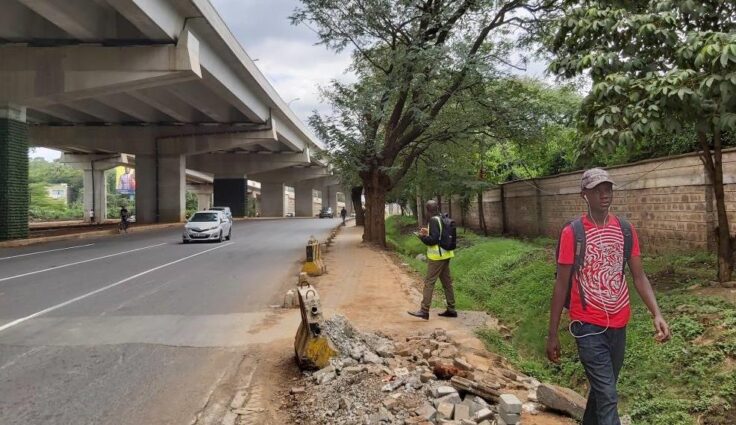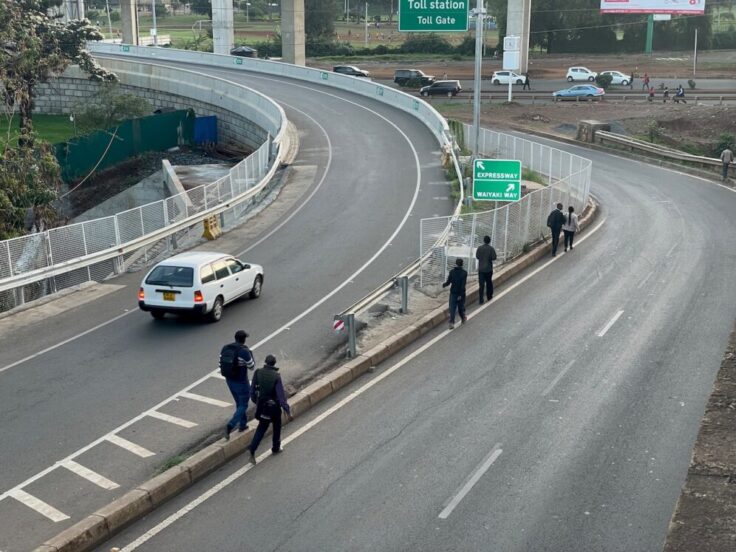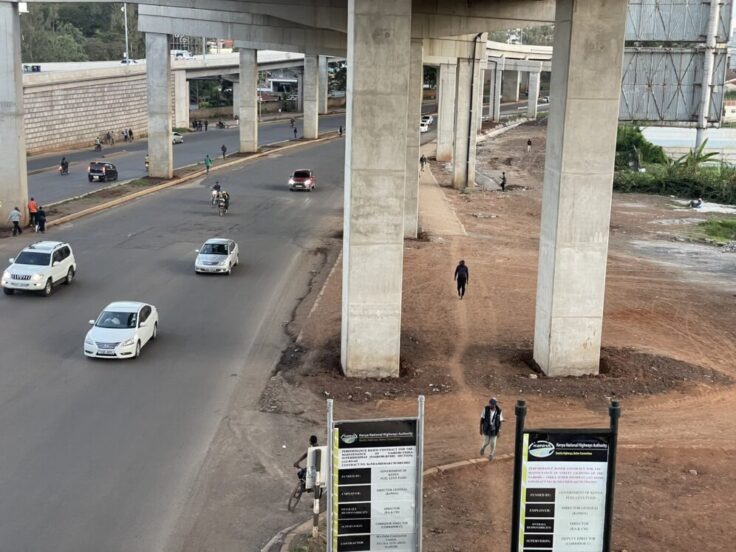July 10, 2023
Reimagining the Nairobi Expressway as a Green Corridor
The Nairobi Expressway, implemented under a build-operate-transfer model by China Road and Bridge Corporation (CRBC), is arguably Kenya’s most distinct urban private-public partnership project.
A version of this article was originally published on ITDP Africa’s Transport Journal here.
Completed in 2022, the Expressway is a 27 kilometer toll road connecting Jomo Kenyatta International Airport to Nairobi’s Westlands area and has been quite popular with motorists. However, the development of this expansive thoroughfare comes at the expense of public transport users, pedestrians, and cyclists — as is the case in many cities around the world, with highway construction bringing a number of health, climate, and equity implications. Non-motorists continue to face daily challenges while traveling along the multi-lane corridor, from physical health and road safety hazards, to inaccessible and prolonged commutes. As Nairobi and other African cities shift towards developing more modern urban infrastructure through the use of public-private partnerships, it is essential that these plans reflect the actual needs of local communities and residents and promote more equitable investments in mobility that do not perpetuate the global legacy of urban highways.
The unfortunate trend towards car-centric city design in Nairobi and other African cities undermines the quality-of-life and character of public spaces that should be made inclusive, accessible, and healthy. Designing for more and faster private vehicles in major urban areas makes pedestrian, cycling, and transit crossings much more dangerous, thereby also limiting access to essential services, employment, and commerce. Residents that face harsh commutes and that have no other option but to walk, cycle, or ride public transport are, as a result, further disadvantaged by environments oriented towards motorists. Without basic amenities such as bus shelters and walkways that make alternatives to driving more attractive, those that are able to drive often choose to do so unnecessarily — perpetuating a cycle of rising congestion and emissions, inefficient commutes, and unsafe conditions for all city dwellers.

It is critical for local officials and planners to rethink the design of Nairobi’s streets to balance the needs of all users, unlike the design of its intercity roads, which continue to primarily be geared towards facilitating vehicles and speeds. It is known that effective urban street design and planning can ensure the safety of all commuters, particularly vulnerable pedestrians and cyclists, and facilitates efficient use of road space by prioritizing public transport, such as buses and trains. It is also important for cities to plan and design functional transport networks based on existing and anticipated commutes that reflect more realistic community needs, travel patterns and times, street usage, and existing mode choices in order to develop complete streets that promote all forms of travel.
Currently, plans are underway to rehabilitate the lower section of the Nairobi Expressway, with the relevant authorities debating plans to build more drainage, install lighting, and re-carpet the old carriageway. This rehabilitation is a great opportunity to go beyond the legacy of car-centric planning and redesign the corridor for equity, efficiency, and inclusion by promoting infrastructure the gives walking, cycling and public transport systems priority — especially given that these are the dominant modes of transport in Kenyan cities. In Nairobi, an estimated 40 percent of daily trips are accomplished by foot and another 41 percent are made with public transport, while only 13 percent of trips are accomplished by car.

Nairobi, like many rapidly growing regional cities, needs more strategic, comprehensive planning to develop a more efficient public transport system that promotes accessible and efficient commutes. This is only possible through the provision of bus rapid transit (BRT) on high-demand corridors and the consideration for basic public transport amenities, such as bus shelters and terminals, on other routes. The rehabilitation of the Expressway needs to include an in-depth analysis of commuter needs, including boarding and alighting locations and transfer patterns, that make multi-modal public transport trips much more convenient.
For example, as the A8 Road of the Expressway is a designated BRT corridor, future rehabilitation should include provisions for high-quality BRT infrastructure, including dedicated median lanes and stations and intersection designs that prioritize buses. Express BRT services can also run on the Expressway and provide access to stops and stations on the road’s lower road as needed. This has significant potential to ease congestion on the lower road and improve commutes for all public transport users.

Beyond buses, the Expressway’s crossings present a number of challenges for walking and cycling — in areas where the the road is elevated (as seen above), pedestrian crossings need to be built at-grade to enable more ease of movement for those on foot or on bicycle. Crossings should be located at pedestrian-desired lines, with universal access and adequate drainage to prevent recurrent issues like flooding. Raised crossings or marked speed humps can also be erected to reduce vehicle speeds close to these safer crossings. With the Expressway focused on accommodating high-speed vehicles, the lower road needs to offer a more conducive environment for pedestrians and cyclists to interact at the street level without the constant danger of traffic. Most of the footpaths on sections of they Uhuru Highway and Waiyaki Way, for example, were demolished to pave the way for the construction of the Expressway, and yet very few have been rehabilitated or redeveloped. Where footpaths exist, the available clear width is inadequate and the footpaths often end abruptly with numerous obstructions, including columns, utility poles, and other construction debris blocking access.
In addition, cars and boda bodas (motorized two-wheelers) often use walkways to avoid traffic along some stretches of roads, including Waiyaki Way and Uhuru Highway, hindering pedestrian mobility and creating more hazards. A lack of universal access forces disabled pedestrians to use the carriageway next to fast-moving vehicles, creating additional concerns for some populations who are least mobile. To improve the design, well-maintained footpaths with at least 2 meters of clear space need be implemented, and they should be also raised above the carriageway with curbs and bollards installed to prevent vehicle encroachment and flooding.

Learn more about the Nairobi Expressway in ITDP Africa’s report here.
Cycling as an option for short trips and first- and last-mile connectivity can be better realized with the implementation of well-designed safe cycle lanes alongside the Expressway. The inclusion of cycle lanes along the A8 Road, for instance, would encourage more cycling access and ease congestion in busy areas such as the Westlands, Upper Hill, Ngong Road, Industrial Area, Nairobi West, Eastlands, South B, and South C. Cycle lanes should also be constructed with smooth service material, such as asphalt or concrete, and be physically separated from the carriageway for safety and to make it more appealing as a transport mode.
For both walking and cycling, adequate shade offers a comfortable and aesthetically pleasing environment in addition to improving the overall quality of public spaces, with more greenery and landscaping an essential element of any attractive urban neighborhood. Moving forward, it is critical that the existing tree canopy cover throughout the Expressway’s routes is improved by planting and maintaining more street trees. Mature, healthy trees act as essential green infrastructure, reducing the heat island effect in the city while also improving the air quality by mitigating the effects of vehicle emissions.
With Kenya’s urban population projected to exceed 22 million by 2030, easing connections to education, employment, and social opportunities is fundamental to the development of the region and its people. Nairobi’s transport decisionmakers urgently need to advance safer, more sustainable, and more equitable mobility strategies to ensure that the city can meet the demands of the future.
